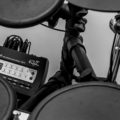Although a drummer plays the entire drum kit as a single instrument, the individual miking of drums and cymbals can result in a complex mixing Music Production - Improve Your Sound - The rise in popularity of work-from-home studios has significantly impacted the music production landscape in recent years, driven by the increasing availability of tools and technology. This growth has led to the emergence of mobile recording rigs, making it possible to record full band performances anywhere. While one might anticipate a wealth of high-quality music,… situation. In genres like rock and country music About Country Music - For a long time in the 21st century, country music played a minor role within the pop music scene. Shortly after World War II, many new radio stations in urban areas focused primarily on this music, often accompanied by local advertising. In the 1930s, country's status was consolidated in the mainstream pop music landscape. The… , the sounds of individual drums and cymbals are often singled out and exaggerated for dramatic effect. This article will provide EQ and compression EQ and Compression Processes For Vocals and Acoustic Guitar - When I first began learning about compressors, I found the technical language quite daunting. In simple terms, compression can be thought of as a method for balancing the loud and soft parts of vocals or instruments, making their behavior more predictable. Compression raises the quiet sections and tames the loud ones, making it easier to… settings for each drum component to help you achieve a great drum sound in your mix.
- Kick Drum: To emphasize the lows and highs of the kick drum, remove some low-mids (around 2 to 4 dB between 350-450 Hz) and boost the clicking sound of the beater (around 2 dB in the 2k-3k range). Use a compression ratio of 2.5:1, with a fast attack (9 ms) and release (11 ms), and apply a noise gate to separate the kick drum sound from the rest of the kit.
- Sub Kick: To emphasize the low-end presence of the sub kick, apply a low pass filter that removes all frequencies above 500 Hz and drops off more dramatically below 100 Hz. Use a compression ratio of 5:1, with a slower attack (120 ms) and medium-fast release (57 ms), and apply a noise gate with a fast attack (20 ms) and slower release (200 ms) to minimize other kit sounds.
- Snare: Boost the low end of the snare by 2-3 dB at around 80 Hz, cut 2-3 dB between 350-450 Hz, and boost again, if necessary, for more high-end brightness, by 1-2 dB at 5k. Use a compression ratio of 2.5:1, with a very fast attack (2 ms) and release (11 ms). Adjust the threshold settings and apply a noise gate with a fast “auto” attack and a slower release to keep out ambient cymbal, tom, and kick sounds.
- Hi-Hat: Use a shelving approach at around 200 Hz to clear out non-essential low-end information and boost between 1-3 dB between 6k and 8k for more high-end shimmer and sizzle. In general, avoid compression on the hi-hat, as it tends to find its own dynamic range without much help.
Keep in mind that these settings are a starting point, and you should adjust them according to the specific drum kit, microphone placement, and drummer. Trust your ears and experiment to achieve the best drum sound for your mix.
Low (Floor) Tom:
To emphasize the low quality of the drum and its high-end snap, apply a dramatic cut of around 12 dB at 500 Hz and a semi-aggressive boost of 4-6 dB at 3k. Use a compression ratio of 4.5:1, with a slower attack of 120 ms and a medium-slow release of 90 ms. Gate the low tom with the fastest “auto” attack and a slow 400 ms release, adjusting the threshold accordingly.
High (Rack) Tom:
For EQ, apply a large cut of around 10 dB at 600 Hz and a big boost of around 7 dB at 2k. Use a compression ratio of 6:1, with a slower attack (100 ms) and a fast release (25 ms). Gate the high tom with the same gate attack and release settings as the low tom, adjusting the threshold accordingly.
Overheads / Room Mics:
Apply a high-pass filter (shelving EQ) at 40 Hz, pull about 5 dB between 100-200 Hz, and boost the overall brightness of the cymbals/kit with a small 1-2 dB boost at 5k. Use a compression ratio of 3:1, with an attack at around 110 ms and a release at a slightly faster 70 ms. Adjust the threshold and the level of the overhead mics in the mix to blend the overall kit sound.
Limiting the Sub Mix:
Send the individual drum tracks to a stereo sub mix and place a limiter, like the Waves L1, on that stereo auxiliary track. Adjust the threshold until the attenuation is between 5-7 dB to achieve a pleasing overall punch and presence for the drum kit.
Remember, these settings are a starting point, and you should adjust them according to the specific drum kit, microphone placement, and drummer. Trust your ears and experiment to achieve the best drum sound for your mix.
Manuel Marino is a seasoned Senior Producer, Music Composer, and Artist with over a decade of experience. He specializes in branded entertainment across various mediums, including video games, films, and advertising campaigns. With 20+ years as a game music composer, Manuel has worked on numerous platforms, creating diverse orchestral soundtracks. HIRE ME


 Manuel is a passionate, driven, and techsavvy AV technician,
Manuel is a passionate, driven, and techsavvy AV technician, 



